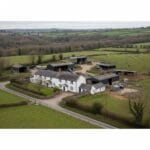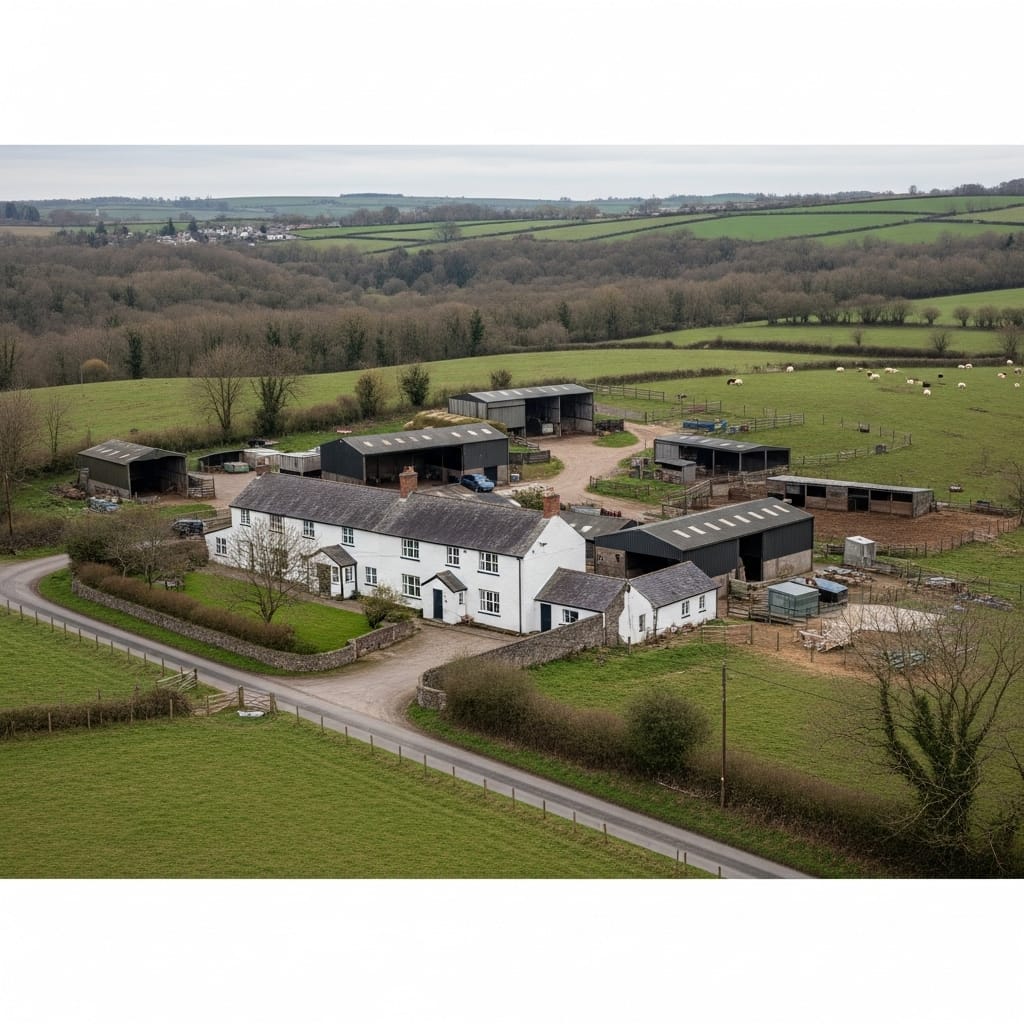
Farms for Sale in the UK: Your Definitive 2025 Guide to Buying the Good Life
There’s a dream that nestles deep in the British soul. It’s a vision of rolling green hills under a vast, open sky, the gentle lowing of cattle in a distant field, and a sturdy farmhouse kitchen warmed by an Aga, with muddy boots kicked off by the door. It’s the dream of owning a farm. For many, it’s a powerful pull away from the clamour of city life towards something more tangible, more real. But turning that pastoral fantasy into a working, breathing reality is one of the biggest journeys you can ever undertake. It’s a decision that involves your heart, your head, and a healthy dose of pragmatism.
Buying a farm isn’t like buying a house. It’s not just bricks and mortar; it’s soil and soul. It’s the purchase of a home, a business, a landscape, and a lifestyle all rolled into one significant investment. Whether you’re dreaming of a smallholding in the Welsh valleys to become self-sufficient, a sprawling arable enterprise in the flatlands of East Anglia, or a vibrant diversified business with a farm shop and café in the Cotswolds, the path to ownership is paved with unique challenges and incredible rewards. This guide is here to walk you through that path, to lift the curtain on the world of UK farms for sale, and to equip you with the knowledge you need to turn that dream into your new address.
Understanding the UK Farm Market Today
The British agricultural landscape is in a state of profound transformation. The departure from the European Union has fundamentally reshaped the financial underpinnings of farming, moving away from the old land-based subsidies of the Basic Payment Scheme (BPS) towards new Environmental Land Management schemes (ELMs). In essence, the government is increasingly paying farmers for public goods – things like cleaner air and water, thriving wildlife, and flood mitigation. For a new buyer, this is a critical concept to grasp. Your potential farm’s ability to generate income may depend as much on its environmental assets as its cropping or stocking capacity.

This shift creates both challenges and exciting opportunities. A farm with ancient woodland, wetlands, or wildflower meadows might now have income streams that were previously undervalued. The market itself is diverse. You’ll find significant regional variations in price and availability. The rugged uplands of Scotland and the north of England might offer more acres for your pound, but the land may be less productive and suitable mainly for hardy livestock. Conversely, the fertile ‘grade 1’ soils of Lincolnshire or Cambridgeshire command a premium for their arable potential. Understanding these regional nuances is the first step in focusing your search.
What Type of Farm is Right for You?
Before you even begin scrolling through listings, the most crucial task is a bit of soul-searching. What kind of farming life are you truly after? Your answer will dictate the size, location, and type of farm you should be looking for.
Arable Farms
This is the domain of big fields and big machinery. Arable farming is focused on growing crops like wheat, barley, oilseed rape, sugar beet, and potatoes. These farms are typically found in the flatter, drier eastern parts of the country. It’s a business of scale, requiring significant capital investment in tractors, combines, and storage facilities. You’ll need a deep understanding of agronomy, soil science, and global commodity markets. The lifestyle can be one of seasonal peaks and troughs – frantic, long days during planting and harvest, and quieter periods for maintenance and planning. An arable farm is a serious commercial enterprise for those with a solid business plan and agricultural experience.
Livestock Farms
The image of a classic farm often involves animals. Livestock farming is the art and science of animal husbandry. This category is incredibly broad:
- Dairy Farms: Demanding a relentless, twice-a-day milking schedule, 365 days a year. It requires specialist infrastructure like milking parlours and slurry storage, and a deep knowledge of herd health and genetics.
- Beef and Sheep Farms: Often found in the wetter, grassier regions of the West Country, Wales, and the North. The work is still constant, revolving around the breeding seasons, but can be less time-critical than dairy. Hill farming, with hardy sheep breeds roaming vast fells, is a particularly challenging but iconic type of livestock operation.
- Pig and Poultry Farms: These are often more intensive, with animals housed indoors in controlled environments. Biosecurity is paramount, and the business model is frequently tied to contracts with large processors.
For all livestock farming, a genuine empathy for animals and a resilience to working outdoors in all weathers are non-negotiable.
Mixed Farms
A generation or two ago, most farms were mixed, combining crops and animals in a synergistic relationship. Animals provided manure for the fields, which in turn grew feed for the animals. This model is seeing a resurgence, particularly within the regenerative agriculture movement. A mixed farm offers diversification and resilience – if crop prices are low, livestock might provide a buffer, and vice versa. However, it requires a broader skillset. You need to be a jack-of-all-trades, competent in both arable management and animal husbandry.
Hobby Farms & Smallholdings
This is the entry point for many aspiring farmers. A smallholding (typically anywhere from one to 50 acres) is less about generating a primary income and more about pursuing a passion for self-sufficiency, raising rare breeds, growing organic vegetables, or keeping a few animals for pleasure. Often, owners will have an off-farm income to support their lifestyle. While the scale is smaller, the commitment is not. Fences still need mending, animals still need feeding, and the land still needs managing, but it offers a more manageable way to live the rural dream without the pressures of a large commercial operation.
Specialist & Diversified Farms
This is arguably the most dynamic and growing sector in UK agriculture. Profitability in modern farming is often found in the niche. Think beyond traditional crops and livestock. The UK is now producing world-class sparkling wine, so vineyards are a growing presence, particularly in the South. Other examples include:
- Equestrian centres with livery yards and riding arenas.
- Organic farms supplying veg box schemes or farmers’ markets.
- Farms with established holiday lets, campsites, or glamping pods.
- Wedding venues set in beautiful, rustic barns.
- Farm shops and cafes that sell direct to the public, capturing the full retail value of their produce.
When looking at farms for sale, considering one with existing diversification, or the potential for it, can be a very shrewd move.
The Nuts and Bolts of Finding and Buying a Farm
Once you’ve narrowed down your vision, it’s time to get practical. The buying process is more complex than a standard house purchase and requires specialist advice.
Setting Your Budget: More Than Just the Asking Price
The listed price of the farm is just the beginning. You must budget for a host of other significant costs. Firstly, there’s tax. In England and Northern Ireland, you’ll pay Stamp Duty Land Tax (SDLT). In Scotland, it’s the Land and Buildings Transaction Tax (LBTT), and in Wales, the Land Transaction Tax (LTT). Farms are often classed as ‘mixed-use’ property, which have different tax rates and thresholds than purely residential properties, so it’s vital to get this calculated correctly. You will need a solicitor specialising in rural property to guide you. On top of this, budget for surveyor’s fees, legal fees, and potentially a valuation fee from your lender. And that’s all before you’ve even bought your first bag of feed or your first tractor. Lenders will want to see a robust business plan demonstrating how you will service the loan, so have your numbers worked out in meticulous detail.
The Search: Where to Look for Farms for Sale
While mainstream property websites do list some farms, your best bet is to engage with specialist rural and agricultural estate agents. Firms like Savills, Knight Frank, and Strutt & Parker have dedicated rural teams, as do many excellent regional and independent agents. They don’t just sell property; they understand land, entitlements, and the intricacies of a farm sale. Register your interest with them, build a relationship, and you may hear about properties before they even hit the open market. Don’t underestimate the power of the local approach, either. Sometimes farms are sold privately through word-of-mouth within the farming community.
Viewing a Farm: Looking Beyond the Farmhouse
It’s easy to fall in love with a charming, wisteria-clad farmhouse. But the real value of a farm is in its land and buildings. When you view a property, put on your most critical hat.
- The Land: Walk as much of it as you can. Dig a small hole. What is the soil like? Is it heavy clay, light sand, or rich loam? Look for signs of poor drainage (rushes, standing water) or soil compaction. Check the quality of fences, gates, and hedges. Are the boundaries clear? Ask about any public rights of way that cross the land.
- The Buildings: Inspect every barn, shed, and outbuilding. Look for structural cracks, leaky roofs, and signs of decay. Are they fit for your intended purpose, or will they require significant investment? Modern agriculture often requires specific buildings, and converting traditional stone barns can be a costly, planning-permission-dependent process.
- Water and Utilities: Where does the water come from? Is it mains supply, or a private source like a borehole or spring? If it’s private, has it been tested for quality and flow rate? How reliable are the electricity and internet connections? A poor internet connection could be a major hindrance for a modern diversified business.
The Legal Labyrinth: Navigating the Purchase Process
The legal side of buying a farm is a minefield for the uninitiated. You absolutely need a solicitor with extensive experience in agricultural conveyancing. They will investigate critical issues such as agricultural ties (which may restrict occupancy of the farmhouse to those solely or mainly employed in agriculture), historic covenants on the land, and sporting or mineral rights that may be owned by a third party. They will also handle the complex transfer of any subsidy entitlements and ensure all aspects of the sale are handled correctly, from the land and farmhouse to the outbuildings and any included stock or machinery (the ‘lock, stock, and barrel’ sale).
Life After the Purchase: Making Your Farm a Success
Getting the keys is a momentous occasion, but it’s the start of the real work. Owning a farm is a continuous journey of learning and adaptation.
The Business of Farming
Remember, your beautiful new home is also a business. Success depends on sound financial management. Maintain meticulous records, understand your cash flow, and develop a clear marketing strategy. Who are you going to sell your products to? Will it be direct to consumers, to local businesses, or into the wider commodity market? Building relationships with suppliers, vets, and other local farmers will be invaluable. Don’t be afraid to seek advice from agricultural consultants or organisations like the National Farmers’ Union (NFU).
Diversification: The Key to Modern Farm Profitability
We’ve touched on this, but it bears repeating. Diversification is your secret weapon. The British public has a huge appetite for authentic rural experiences and high-quality local produce. Look at your new farm with creative eyes. Could that rundown barn become a stunning wedding venue? Does that south-facing slope have potential for a vineyard? Could a spare field host a small, quiet campsite or some luxury glamping pods? Could you convert a building into a farm office to rent out? Generating multiple income streams provides resilience against the volatility inherent in traditional farming and can transform the profitability of your enterprise.
Embracing the Community and Lifestyle
Finally, embrace the life. Farming can be isolating, but it exists within a strong, supportive community. Your neighbours will be an invaluable source of help and advice. Get involved, join local discussion groups, and don’t be too proud to ask for help when your tractor gets stuck in a muddy gateway (it will happen!). Prepare for the sheer hard work, the antisocial hours, and the emotional toll of dealing with sick animals or a failed crop. But also prepare for the immense satisfaction of a successful harvest, the joy of seeing new life born on your land, and the profound connection to the seasons and the earth.
Buying a farm is more than a transaction; it’s a commitment to a way of life. It requires research, resilience, and a healthy dose of realism to balance the romance. But for those who get it right, the reward is unparalleled: the chance to be a custodian of a small piece of the British countryside and to truly live the good life.







